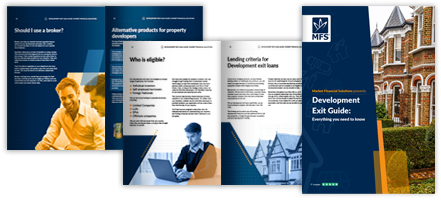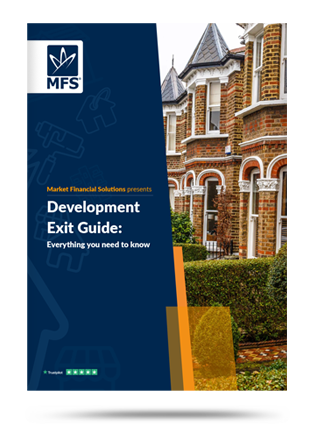Market Financial Solutions are a bridging loan and buy-to-let mortgage provider and are not legal, financial, investment or tax advisers. This document is for informational purposes only and does not, and should not be considered, to constitute legal, financial, investment or tax advice or be relied upon by any person to make a legal, financial, investment or tax decision. Therefore, Investors are encouraged to seek appropriate professional advice. The information in this content is correct at time of writing.

Every property investor or expanding landlord will need a clear property investment exit strategy. Especially if they’re utilising specialist finance.
Broadly, those purchasing a home to live in, and those investing in property as an asset class, will be seeking very different types of finance. A regulated mortgage may be slowly repaid over 25 years. Whereas a bridging loan usually needs to be covered quickly in mere months, as it’s a short-term product.
But what exactly is a property investment exit strategy? And what kind options are available to property investors? We will explore these questions in this blog.
What Is An Exit Strategy?
An exit strategy is the plan a borrower(s) put into place to repay their loan. In our context, a property investment exit strategy is how a borrower covers their bridging loan, bespoke BTL mortgage, or bridge fusion funding.
Commonly, there are two main types of exit strategy that are utilised by bespoke borrowers: a resale of property, or refinancing with a long-term lender. A borrower can sell the security property – or another one they own – to cover the finance. Refinancing with a long-term lender may be a better option for those who are in the process of securing tenants, tidying up their finances, or renovating their assets.
Within these categories, there are a few niche options which may be especially suitable for property investors.
Property Flipping
A property investment exit strategy in the bridging world will likely revolve around speed. A borrower will need funding quickly to secure an opportunity, and then turn around that investment as quickly as possible.
This is the driving force behind flipping strategies. Here, an investor purchases a property (that’s often run down or undervalued), improves its desirability, and then sells it – or flips it – at a higher value.
Getting to grips with property flipping exit strategies may prove important over the coming months. Soon, the Renters’ Rights Bill will come into play, and it will force landlords to adhere to much more stringent rules. This includes hitting a “Decent Homes Standard[1]”.
Many landlords have chosen to sell up rather than face these challenges[2], and more may yet abandon the market. As such, many BTL properties are coming to the market, often in less-than-ideal conditions[3]. As the market adapts to new legislation, there could be opportunities for expanding investors.

Cash From Other Assets Or Investments
Selling an asset for a property investment exit strategy is common, but the sale doesn’t need to come from the security property itself. Indeed, those with large portfolios or external assets may choose to liquidate another investment to cover finance.
The data suggests a sizable majority of landlords are professionalised. According to the latest quarterly Landlord Trends report[4], the proportion of homes held within limited companies has risen to 66%, compared to 36% in 2020. Also, landlords who have at least one property held within a limited company own, on average, 14.6 properties, compared to 5.2 among those whose entire portfolio is held in their personal name.
What’s more, there is the wider portfolio to consider. According to our own independent research[5], property makes up roughly 8% of the average investor’s entire holdings. The remainder is made up of equities, bonds, commodities, and more. So long as it works for their circumstances, investors can sell these kinds of assets to cover their property finance.
What’s important to remember is that lenders will need to see clear evidence of this. They’re unlikely to lend to a borrower whose exit strategy involves the “possibility” of selling some shares.
Development Exit
Another property investment exit strategy that’s likely to come to the forefront for those building units over the coming months is development exits. Generally, property development projects can end up experiencing unforeseen challenges or delays. When this occurs, development exit finance can help.
This is funding that can cover the original ground up funding, and provide extra time and breathing space for developers to finalise their projects. This could prove crucial, given how much focus is on getting the UK building at the moment.
The Planning and Infrastructure Bill[6] is currently making its way through the system and it aims to make it easier than ever to develop in the UK. Moreover, there are National Planning Policy Framework updates[7], and reintroduced mandatory housebuilding targets[8] will ramp up building efforts over the coming months. As developers get in on the action, demand for development exit finance could skyrocket.
Internal Exit Strategies
Often, property investment exit strategies will be thought of as an external concern. But it is possible to exit a product within the same company.
At Market Financial Solutions for example, a borrower may use a bridging loan to purchase a house they plan to rent out. Perhaps they’ll also utilise some of our funding to upgrade the space to draw in potential tenants.
Once this is all wrapped up, they could then move onto one of our residential BTL mortgages to get the rental ball rolling.
For this exit strategy, along with all the others previously mentioned and others like them, there are a few key elements we need to be aware of before we can deliver funding. Our underwriters will need to see documented evidence for the exit strategy at hand, such as a mortgage in principle or clear options, sale contracts, etc. We’ll need clear timelines and, for perhaps riskier or more challenging deals, contingency plans if the primary exit strategy falls through.
The second half of 2025 is set to be filled with dramatic shifts in the property market. Borrowers need to ensure they have thought through their property investment exit strategy for the months ahead.
Development Exit Finance
A complete guide
Everything you need to know
- Benefits & costs
- Difference to development finance
- Application & loan process
- Repayment options
[1] https://www.landlordtoday.co.uk/breaking-news/2025/05/over-a-fifth-of-rental-properties-set-to-fail-decent-homes-standard/
[2] https://www.thisismoney.co.uk/money/buytolet/article-14447891/More-landlords-properties-sale-thanks-tougher-regulations-taxes.html
[3] https://www.propertyreporter.co.uk/features/are-we-likely-to-see-a-surge-in-property-flipping.html
[4] https://www.mortgagestrategy.co.uk/news/majority-of-landlords-plan-to-buy-under-limited-company-structures-fhl/
[5] https://www.mfsuk.com/investment-diversification/
[6] https://www.gov.uk/government/news/biggest-building-boom-in-a-generation-through-planning-reforms
[7] https://www.gov.uk/government/news/planning-overhaul-to-reach-15-million-new-homes
[8] https://www.cbre.co.uk/insights/articles/will-the-revised-national-planning-policy-framework-help-achieve-the-governments-new-homes-target






